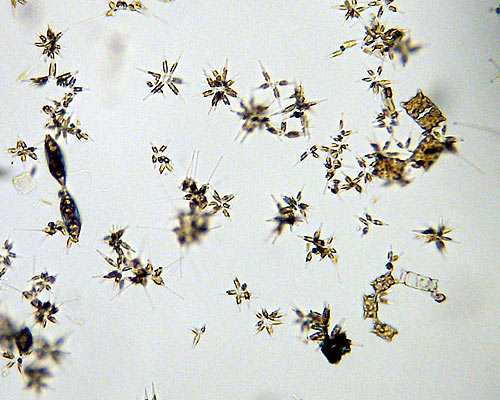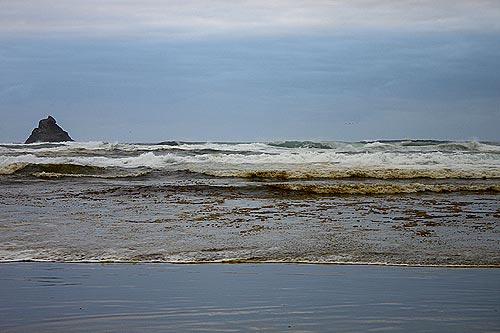Brown Surf Causing a Stir on Oregon Coast
Published 04/08/2010
 |
| Brown foam in Newport (photo Terry Morse) |
(Oregon Coast) – Residents and tourists alike have been mystified and even alarmed by hordes of brown foam along the Oregon coast, thinking it’s pollution or an oil spill of some kind.
In fact, the culprit is a sign of a very healthy ocean: tiny, microscopic creatures called diatoms, which are a form of phytoplankton.
What does make this appearance of the little critters rather unusual is that it’s also hitting the central coast, whereas normally it’s seen from Seaside up through the southern Washington coast.
Keith Chandler, manager of Seaside Aquarium, said it’s been happening on and off for several weeks in that area. There, it can make the waves very brown. But it started appearing along Lincoln County beaches, like Seal Rock, Newport and Depoe Bay, and this caused some residents to call the Oregon Department of Environmental Quality (DEQ) out of concern.

Tiffany Boothe of Seaside Aquarium put the diatoms under a microscope (photo Seaside Aquarium)
Steve Schnurbusch, with the DEQ office in Salem, said some residents feared it might be pollutants from a paper plant up the Yaquina River. His office collected a sample, and analysis under a microscope confirmed it was indeed only this form of phytoplankton.
In Seaside, tourists will often flood local businesses and tourism entities with questions about the brown stuff, also fearful it’s pollution of some kind.
“It’s a good thing,” said Chandler. “It’s a healthy thing. It’s just a lot of diatoms.”
Diatoms are microscopic plant-like creatures that are actually responsible for most all sea foam you see on the beaches. They are about 100 micrometers long – or 1000 times the size of a virus. Still, they’re not visible with the naked eye.
 |
| The brown foam can sometimes create chunks of brown goo floating around the beaches - but they're a good thing. |
This particular phytoplankton is so abundant right now on the north coast that it’s causing really dark patches along with very dark, brown chunks of foam in the Seaside area. In recent weeks, this was so along most of the Oregon coast, including the central coast, where big chunks of brown foam floated lazily along the waves. There it would create dark, oily-looking patches in the sand as well as large tracts of brown foam and goo along the beaches.
Terry Morse caught a photo of it in Newport on Wednesday. The Whale Watch Center in Depoe Bay said it’s been going on for a time, and that the brown stuff was more prominent on some days than others.
The diatoms thrive off large amounts of nitrates and phosphates, which are extremely heavy in the freshwater runoffs from the Columbia River, Chandler said.
 |
| Brown waves as seen from above. |
“That’s why it’s so brown here on these beaches," he said. " They’re living off the nitrates and phosphates coming down from the Columbia. That creates these huge blooms of diatoms. They’ve got a lot of stuff to feed off. It’s like gravy to these diatoms. Or like pudding to them.”
Schnurbusch said although it’s rarer on the central coast, given the right conditions it will happen there as well.
“We’ve got the Yaquina River here, and when it rains heavily you get a lot of the nutrients coming down to spark these enormous blooms,” Schnurbusch said. “Then all you need is a bit of sunshine, which we had as well. These are plants, so they do work on photosynthesis.”
These enormous blooms often come with side effects – or more accurately, they mean some other interesting things could be in store for the coast.
 |
| Seaside's waves have been looking like this lately (photo Seaside Aquarium) |
Often, large blooms of the brown diatoms or the usual diatoms that are responsible for sea foam mean there are other kinds of phytoplankton about. A form of these called dinoflagellates are bioluminescent – creating what is called the “glowing sands” phenomenon. Your chances of seeing these at night on the beaches are greater during these heavy bloom events.
Those heavy nutrient runoffs from the Columbia mean more diatoms in general for the area between Tillamook Head and the Long Beach Peninsula, which is what makes the razor clam population thrive in that section of the northwest coast.
Chandler said 80 percent of the state’s razor clams are on Clatsop County beaches.
Some chatter on the internet about this diatom bloom has resulted in some misinformation. For instance, some members of the public who have left comments on a story on the subject on Eugene station KVAL’s website have erroneously stated the phosphates and other nutrients coming from freshwater streams are fecal matter of some kind. While the TV station’s story is correct, the commenters are incorrect. These are naturally occurring nutrients and do not pose problems down the food chain to humans. Oregon Coast Lodgings for this event - Where to eat - Maps - Virtual Tours
More of brown waves on the north Oregon coast below:

More About Oregon Coast hotels, lodging.....
More About Oregon Coast Restaurants, Dining.....
LATEST Related Oregon Coast Articles
Likely just before dawn best hour but peak happens during daylight. Weather
Dark Sky Week is Prime Along Oregon Coast: Where and Where Not to Go
General guide to dark sky viewing from south to north coast. Astronomy
Sizable Price Drop, Deals in Lincoln City During Quiet of April on Central Or...
20 perc off at A1 Vacation Rentals across its roster, including Gleneden Beach. Lincoln City specials
Upcoming S. Oregon Coast Events Include Gem Show, History: Coos Bay, Bandon
May 6 talk at Coos History Museum, Mayfly Fest May 17, Bandon Rock / Gem Show June 7,8
Washington Coast Cleanup on April 19 - Coinciding with Oregon Coast's SOLVE E...
From the Puget Sound to Long Beach, alongside Oregon's cleanup. Washington coast events, Seaside events
Astoria's Riverwalk Gets New Lighting, More N. Oregon Coast Roadwork
Delays coming this summer, but the riverwalk has a new look. Seaside, Cannn Beach
April Gets Even Cheaper Midweek at Depoe Bay, Lincoln City: Oregon Coast Deals
Off-season rates plus more at Keystone Vacation Rentals. Depoe Bay lodging specials, Lincoln City hotel reviews, Newport hotel reviews
Washington Coast Begins Week of Clam Digs, April 12 Through 18
Long Beach, Twin Harbors, Mocrocks and Copalis at different times. Washington coast events
Back to Oregon Coast
Contact Advertise on BeachConnection.net
All Content, unless otherwise attributed, copyright BeachConnection.net Unauthorized use or publication is not permitted











































